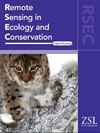利用GEDI和国家森林清查数据研究墨西哥地上森林生物量的空间分布和驱动因素
IF 4.3
2区 环境科学与生态学
Q1 ECOLOGY
引用次数: 0
摘要
准确评估森林地上生物量密度(AGBD)对于了解植被在减缓气候变化方面的作用以及在国家和区域各级制定森林管理和环境政策至关重要。全球生态系统动力学调查(GEDI)使用全波形激光雷达,为估计AGBD提供了有价值的工具。利用当地实地数据校准GEDI生物质产品对于提高模型准确性至关重要,因为目前的估算依赖于全球数据集。此外,评估影响生物量估算的关键因素对于完善基于GEDI的模型至关重要。在本研究中,我们以田间AGBD为因变量,以GEDI指标为自变量,对线性模型进行了校准,并与不同林种的GEDI L4A产品进行了性能比较。此外,我们还评估了地形坡度、森林结构复杂性和森林类型对模型精度的影响。最后,我们通过汇总足迹水平估计值与当地模型,绘制了墨西哥的AGBD地图,并将其与GEDI AGBD地图(L4B产品)进行了比较。模型验证表明,不同森林类型的R2值在0.35 ~ 0.46之间,大多数模型的%RMSE低于52.0。误差比GEDI L4A低32.7 ~ 34.2%,精度有显著提高。报告估计墨西哥的碳储量约为17.8亿吨,与粮农组织的官方估计非常接近,而GEDI的估计比官方估计高出33.5%。在坡度适中、森林结构复杂性较低的地区,利用GEDI估算生物量最准确。针叶林和热带森林用GEDI估算AGBD的误差最小(分别为%RMSE的46.7%和47.3%),这可能是由于热带森林中广泛存在均匀结构的针叶树和温和的地形坡度。我们的研究结果强调了用GEDI森林结构指标校准当地AGBD数据对改善足迹和国家层面的生物量估算的重要性。本文章由计算机程序翻译,如有差异,请以英文原文为准。
Spatial distribution and drivers of aboveground forest biomass in Mexico using GEDI and national forest inventory data
Accurate assessment of forest aboveground biomass density (AGBD) is essential for understanding the role of vegetation in climate change mitigation and developing forest management and environmental policies at national and regional levels. The Global Ecosystem Dynamics Investigation (GEDI) uses full‐waveform LiDAR and provides a valuable tool for estimating AGBD. Calibrating GEDI biomass products with local field data is vital for improving model accuracy, as current estimates rely on global datasets. Additionally, evaluating key factors that influence biomass estimation is essential to refine GEDI‐based models. In this research, we calibrated linear models with field AGBD as the dependent variable and GEDI metrics as independent variables, and compared the performance against the GEDI L4A product across forest types. Additionally, we evaluated the effects of terrain slope, forest structural complexity, and forest type on the accuracy of the models. Finally, we mapped AGBD in Mexico by aggregating footprint‐level estimates with local models and compared it with the GEDI AGBD map (L4B product). Model validation showed R 2 values from 0.35 to 0.46 across forest types, with most models having %RMSE below 52.0. Errors were 32.7 to 34.2% lower than GEDI L4A, highlighting a notable accuracy improvement. The total carbon stocks in Mexico estimated here are approximately 1.78 Gt, aligning closely with official FAO estimates, whereas GEDI estimates are 33.5% higher than the official estimate. Biomass estimation with GEDI is most accurate in areas with moderate slopes and low forest structural complexity. Coniferous and tropical forests showed the lowest errors in estimating AGBD with GEDI (46.7 and 47.3 of %RMSE, respectively) likely due to the widespread presence of uniformly structured coniferous trees and the moderate terrain slopes found in tropical forests. Our findings highlight the importance of calibrating local AGBD data with GEDI forest structure metrics to improve biomass estimations at the footprint and national levels.
求助全文
通过发布文献求助,成功后即可免费获取论文全文。
去求助
来源期刊

Remote Sensing in Ecology and Conservation
Earth and Planetary Sciences-Computers in Earth Sciences
CiteScore
9.80
自引率
5.50%
发文量
69
审稿时长
18 weeks
期刊介绍:
emote Sensing in Ecology and Conservation provides a forum for rapid, peer-reviewed publication of novel, multidisciplinary research at the interface between remote sensing science and ecology and conservation. The journal prioritizes findings that advance the scientific basis of ecology and conservation, promoting the development of remote-sensing based methods relevant to the management of land use and biological systems at all levels, from populations and species to ecosystems and biomes. The journal defines remote sensing in its broadest sense, including data acquisition by hand-held and fixed ground-based sensors, such as camera traps and acoustic recorders, and sensors on airplanes and satellites. The intended journal’s audience includes ecologists, conservation scientists, policy makers, managers of terrestrial and aquatic systems, remote sensing scientists, and students.
Remote Sensing in Ecology and Conservation is a fully open access journal from Wiley and the Zoological Society of London. Remote sensing has enormous potential as to provide information on the state of, and pressures on, biological diversity and ecosystem services, at multiple spatial and temporal scales. This new publication provides a forum for multidisciplinary research in remote sensing science, ecological research and conservation science.
 求助内容:
求助内容: 应助结果提醒方式:
应助结果提醒方式:


